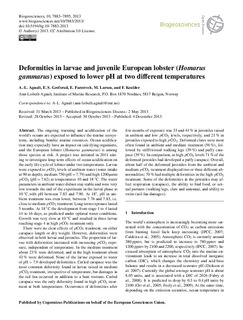| dc.contributor.author | Agnalt, Ann-Lisbeth | |
| dc.contributor.author | Grefsrud, Ellen Sofie | |
| dc.contributor.author | Farestveit, Eva | |
| dc.contributor.author | Larsen, Marita | |
| dc.contributor.author | Keulder, Felicia | |
| dc.date.accessioned | 2014-01-24T13:09:51Z | |
| dc.date.available | 2014-01-24T13:09:51Z | |
| dc.date.issued | 2013-12-04 | |
| dc.identifier.citation | Agnalt, A.-L., Grefsrud, E. S., Farestveit, E., Larsen, M., and Keulder, F.: Deformities in larvae and juvenile European lobster (Homarus gammarus) exposed to lower pH at two different temperatures, Biogeosciences, 10, 7883-7895, doi:10.5194/bg-10-7883-2013, 2013. | no_NO |
| dc.identifier.issn | 1726-4189 | |
| dc.identifier.uri | http://hdl.handle.net/11250/109313 | |
| dc.description.abstract | The ongoing warming and acidification of the world's oceans are expected to influence the marine ecosystems, including benthic marine resources. Ocean acidification may especially have an impact on calcifying organisms, and the European lobster (Homarus gammarus) is among those species at risk. A project was initiated in 2011 aiming to investigate long-term effects of ocean acidification on the early life-cycle of lobster under two temperatures. Larvae were exposed to pCO2 levels of ambient water (water intake at 90 m depth), medium 750 (pH = 7.79) and high 1200 μatm pCO2 (pH = 7.62) at temperatures 10 and 18 °C. The water parameters in ambient water did not stay stable and were very low towards the end of the experiment in the larval phase at 10 °C,with pH between 7.83 and 7.90. At 18°, pH in ambient treatment was even lower, between 7.76 and 7.83, i.e. close to medium pCO2 treatment. Long-term exposure lasted 5 months. At 18 °C the development from stage 1 to 4 lasted 14 to 16 days, as predicted under optimal water conditions. Growth was very slow at 10 °C and resulted in three larvae reaching stage 4 in high pCO2 treatment only. There were no clear effects of pCO2 treatment, on either carapace length or dry weight. However, deformities were observed in both larvae and juveniles. The proportion of larvae with deformities increased with increasing pCO2 exposure, independent of temperature. In the medium treatment about 23% were deformed, and in the high treatment about 43% were deformed. None of the larvae exposed to water of pH >7.9 developed deformities. Curled carapace was the most common deformity found in larvae raised in medium pCO2 treatment, irrespective of temperature, but damages in the tail fan occurred in addition to a bent rostrum. Curled carapace was the only deformity found in high pCO2 treatment at both temperatures. Occurrence of deformities after five months of exposure was 33 and 44% in juveniles raised in ambient and low pCO2 levels, respectively, and 21% in juveniles exposed to high pCO2. Deformed claws were most often found in ambient and medium treatment (56%, followed by stiff/twisted walking legs (39%) and puffy carapace (39%). In comparison, at high pCO2 levels 71% of the deformed juveniles had developed a puffy carapace. Overall, about half of the deformed juveniles from the ambient and medium pCO2 treatment displayed two or three different abnormalities; 70% had multiple deformities in the high pCO2 treatment. Some of the deformities in the juveniles may affect respiration (carapace), the ability to find food, or sexual partners (walking legs, claw and antenna), and ability to swim (tail-fan damages). | no_NO |
| dc.language.iso | eng | no_NO |
| dc.publisher | European Geosciences Union | no_NO |
| dc.title | Deformities in larvae and juvenile European lobster (Homarus gammarus) exposed to lower pH at two different temperatures | no_NO |
| dc.type | Journal article | no_NO |
| dc.type | Peer reviewed | no_NO |
| dc.subject.nsi | VDP::Agriculture and fishery disciplines: 900::Fisheries science: 920::Resource biology: 921 | no_NO |
| dc.source.pagenumber | 7883-7895 | no_NO |
| dc.source.volume | 10 | no_NO |
| dc.source.journal | Biogeosciences | no_NO |
| dc.identifier.doi | 10.5194/bg-10-7883-2013 | |
